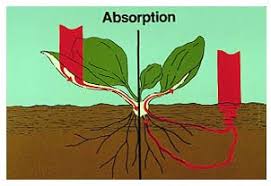W.B.C.S. Examination Notes On – Absorption Of Water In Plants – Agriculture Notes.
In higher plants water is absorbed through root hairs which are in contact with soil water and form a root hair zone a little behind the root tips.Continue Reading W.B.C.S. Examination Notes On – Absorption Of Water In Plants – Agriculture Notes.
Root hairs are tubular hair like prolongations of the cells of the epidermal layer (when epidermis bears root hairs it is also known as piliferous layer) of the roots. The walls of root hairs are permeable and consist of pectic substances and cellulose which are strongly hydrophilic (water loving) in nature. Root hairs contain vacuoles filled with cell sap.
When roots elongate, the older hairs die and new root hairs are developed so that they are in contact with fresh supplies of water in the soil.
Mechanism of water absorption is of two types:
(1) Active Absorption of Water:
In this process the root cells play active role in the absorption of water and metabolic energy released through respiration is consumed.
Active absorption may be of two kinds:
(a) Osmotic absorption i.e., when water is absorbed from the soil into the xylem of the roots according to the osmotic gradient.
(b) Non-osmotic absorption i.e., when water is absorbed against the osmotic gradient.
(2) Passive Absorption of Water:
It is mainly due to transpiration, the root cells do not play active role and remain passive.
(1a) Active Osmotic Absorption of Water:
First step in the osmotic absorption of water is the imbibition of soil water by the hydrophilic cell walls of root hairs. Osmotic Pressure (O.P.) of the cell-sap of root hairs is usually higher than the O.P. of the soil water. Therefore, the Diffusion Pressure Deficit (D.P.D.) and the suction pressure in the root hairs become higher and water from the cell walls enters into them through plasma-membrane (semi-permeable) by osmotic diffusion. As a result, the O.P., suction pressure and D.P.D. of root hairs now become lower, while their turgor pressure is increased.
Now, the cortical cells adjacent to root hairs have higher O.P., suction pressure and D.P.D. in comparison to the root hairs. Therefore, water is drawn into the adjacent cortical cells from the root-hairs by osmotic diffusion.
In the same way, the water by cell to cell osmotic diffusion gradually reaches the innermost cortical cells and the endodermis. Osmotic diffusion of water into endodermis takes place through special thin walled passage cells because the other endodermal cells have casparian strips on their walls which are impervious to water.
Water from endodermal cells is drawn into the cells of pericycle by osmotic diffusion which now becomes turgid and their suction pressure is decreased. In the last step, water is drawn into xylem from turgid pericycle cells. (In roots the vascular bundles are radial and protoxylem elements are in contact with pericycle).
It is because in absence of turgor pressure of the xylem vessels (which are non-elastic), the suction pressure of xylem vessels becomes higher than the suction pressure of the cells of the pericycle. When water enters into xylem from pericycle, a pressure is developed in the xylem of roots which can raise the water to a certain height in the xylem. This pressure is called as root pressure.
(1b) Active Non-Osmotic Absorption of Water:
Sometimes, it has been observed that absorption of water takes place even when the O.P. of the soil water is higher than the O.P. of cell-sap. This type of absorption which is non- osmotic and against the osmotic gradient requires the expenditure of metabolic energy probably through respiration.
Following evidences support this view:
(i) The factors which inhibit respiration also decrease water absorption.
(ii) Poisons which retard metabolic activities of the root cells also retard water absorption.
(iii) Auxins (growth hormones) which increase metabolic activities of the cells stimulate absorption of water.
(2) Passive Absorption of Water:
Passive absorption of water takes place when rate of transpiration is usually high. Rapid evaporation of water from the leaves during transpiration creates a tension in water in the xylem of the leaves. This tension is transmitted to water in xylem of roots through the xylem of stem and the water rises upward to reach the transpiring surfaces.
As a result, soil water enters into the cortical cells through root hairs to reach the xylem of roots to maintain the supply of water. The force for this entry of water is created in leaves due to rapid transpiration and hence, the root cells remain passive during this process.
Please subscribe here to get all future updates on this post/page/category/website


 +919674493673
+919674493673  mailus@wbcsmadeeasy.in
mailus@wbcsmadeeasy.in







































































































